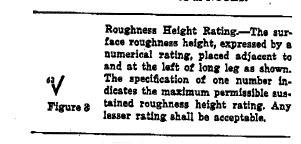RoarkS
Mechanical
- Jul 10, 2009
- 264
Howdy!
So I have a customers print sitting in front of me with a general surface finish symbol on a face, and it relates to a note. The note states: "surface marked to have 125"
Everyone at the shop says that it implies 125 or better... and they also say nobody will have an issue if we make it better than they asked.
My argument is that it says "to have". not "or better" or some other ambiguous verbiage. It may need increased friction on one surface...but I don't know what it does. I just have a print.
on the flip side to that my mind then wonders... whats the tolerance on a 125 surface finish!? I have a surface finish tester and the comparison plates... if comparison plates used... better than 250, but rougher than 63?
Whats the word... is our 8 micro inch finish going to get rejected?
So I have a customers print sitting in front of me with a general surface finish symbol on a face, and it relates to a note. The note states: "surface marked to have 125"
Everyone at the shop says that it implies 125 or better... and they also say nobody will have an issue if we make it better than they asked.
My argument is that it says "to have". not "or better" or some other ambiguous verbiage. It may need increased friction on one surface...but I don't know what it does. I just have a print.
on the flip side to that my mind then wonders... whats the tolerance on a 125 surface finish!? I have a surface finish tester and the comparison plates... if comparison plates used... better than 250, but rougher than 63?
Whats the word... is our 8 micro inch finish going to get rejected?

